If you're keen on giving your body a natural boost, you've probably heard about the mighty shiitake mushroom. Renowned not just for its delicious taste but also for its impressive health benefits, shiitake has been a star in traditional medicine for ages.
Now, what if we told you that you could capture all that goodness in a bottle?
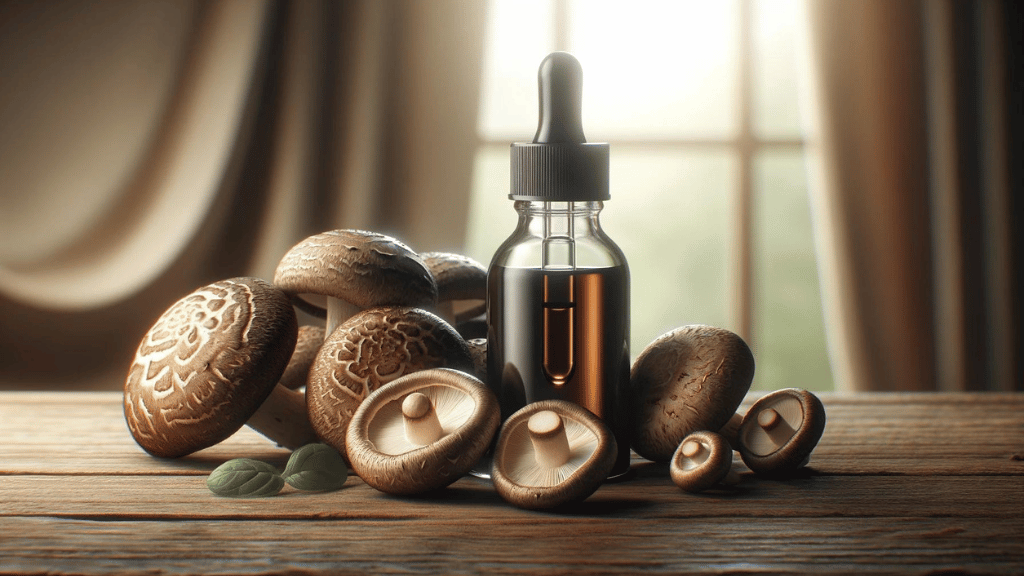 That's right, we're talking about making your own shiitake mushroom tincture at home!
That's right, we're talking about making your own shiitake mushroom tincture at home!
It's easier than you think, and we're here to guide you through each step.
How to find the best shiitake mushrooms for your tincture
Before you start, you need to find some top-notch shiitake mushrooms. Local farmers' markets or health food stores are treasure troves for fresh picks. Look for mushrooms with a firm, plump appearance and a fresh, earthy smell.
Avoid any that seem slimy or have some fuzzy mold starting – that's a no-go zone.
If fresh ones are playing hard to get, dried shiitake mushrooms are equally potent and can be sourced from reputable online suppliers.
Did you know that your local supermarket, specialty food store, or farmer's market is likely to carry shiitake mushrooms?
If you're shopping for fresh shiitake, here are some characteristics to look for before you buy mushrooms for your tincture.
Fresh shiitake mushroom buying tips:
-
Look for firm mushrooms: Fresh shiitake mushrooms should be firm to the touch. Avoid any mushrooms that feel slimy or have soft spots, as these are signs of decay.
-
Check the cap and edges: Fresh shiitake mushrooms have a characteristic umbrella-shaped cap that's slightly curled under at the edges. The cap should be intact and the edges should not be dry or cracked, which can indicate age or improper storage.
-
Inspect the gills: Look underneath the cap at the gills. They should be intact and clean. Avoid mushrooms with damaged or overly wet gills, as this can affect the quality and taste of your tincture.
-
Smell the mushrooms: Fresh shiitake mushrooms have a woodsy, earthy smell. Any off-odors or a strong unpleasant smell can indicate that the mushrooms are past their prime.
-
Examine the stem: The stem should be relatively dry and firm. While the stem is often removed before making a tincture due to its tougher texture, its condition can still indicate the overall freshness of the mushroom.
-
Look at the color: Fresh shiitake mushrooms typically have a brown cap with a slightly lighter, tan gill area. Any discoloration or spots can indicate age or spoilage.
-
Consider their storage: When buying shiitake mushrooms, check how they are stored. They should be kept in a cool, dry place. Mushrooms stored in airtight packaging or in damp conditions may not be fresh.
How many shiitake mushrooms do you need for your tincture?
The amount of mushrooms needed for making a tincture can vary depending on the desired strength of the tincture and the volume you plan to make. Typically, tinctures are made with a ratio of plant material to solvent (in this case, alcohol) that can range from 1:2 to 1:5 by weight for dried material and 1:5 to 1:10 for fresh material, given the water content in fresh mushrooms.
For shiitake mushrooms, which are generally used dried for tinctures due to their concentrated form and easier storage, you might follow a standard ratio of 1 part dried mushrooms to 5 parts alcohol by weight. This ratio ensures that the alcohol is able to extract the beneficial compounds effectively.
"When we're at the supermarket, we like to grab a couple handfuls. This will usually make enough tincture for the cold & flu season. We use a 1:3 ratio here at our house and it works great for when we feel a cold coming on. "
Here's a general guideline:
- To make a small batch of tincture, such as 500ml (about 17 ounces), you might start with 166 grams (that's around 6 ounces) of dried shiitake mushrooms and 500ml of alcohol.
- If you're using fresh shiitake mushrooms, remember they contain a lot of water, so you would need more by weight. Since fresh mushrooms are less commonly used for tinctures due to their moisture content, it's HIGHLY recommended that you dry them first for a more potent and shelf-stable tincture.
Here's a complete guide to drying mushrooms if it's your first time.
Some adjustments to consider:
- The strength of the tincture can be adjusted by altering the ratio of mushrooms to alcohol. More mushrooms will result in a stronger tincture, while more alcohol will dilute it.
- It's also important to consider the intended use of the tincture when deciding on the amount of mushrooms. For general wellness, a standard ratio is sufficient, but for specific therapeutic uses, you might want to consult with a healthcare provider or a herbalist.
What if I'm just really, really bad at math and this still confuses me?
English major here, so I can relate.
We like to use a 1:3 ratio here at home.
Here's some advice: once your shiitakes are good and dried, unceremoniously shove them into a measuring cup. Pack them in there really good. How much is in there? That's your one ratio. Now, measure out that one volume by three times in alcohol.
For example, if your dried mushrooms fill one cup, then you'd use three cups of vodka for your tincture. Use less vodka (or add more mushrooms!) if you want your tincture to be stronger to adjust your ratio. Mushroom medicine is not an exact science, so just experiment and have fun with it!
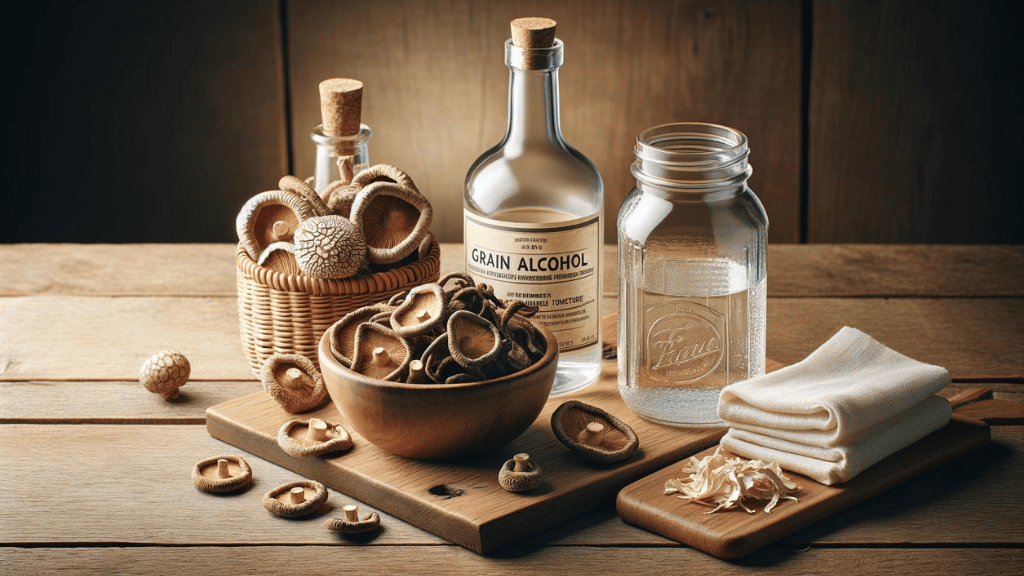
What you need to make shiitake tincture
If it's your first time ever making mushroom tincture, we are so happy you're here. You're going to love how easy it is. In fact, you might start tincturing every medicinal mushroom and herb in your garden.
Here's what you need to make mushroom tincture:
1. Dried mushrooms
It's so easy to dry mushrooms yourself. You don't need any special equipment. Simply chop off the very dense end of the stem (you can leave most of the stem on!) and then slice your mushrooms into 1/8-1/4 inch slices. There's no special trick here! Lay them out flat to air dry, use your oven on the lowest temp, or use a commercial dryer!
Other mushrooms you can consider adding to your shiitake mix: maitake, lion's mane, reishi, chaga, and oysters all make great tinctures! Best of all, the steps are really the same regardless of the mushroom you use.
2. High-proof alcohol
High-proof alcohol is the foundation of any tincture. Vodka or grain alcohol works wonders. It doesn't matter what you use as long as the proof is higher than 80. You could go as high as 120 proof.
We really like Tito's Vodka for tincture making because of the balance between quality and price. And it's gluten free.
Everclear would also work well if you want a higher potency.
Some people prefer brandy for the taste.
It's up to you, friend!
3. A glass jar with a tight-fitting lid
Hooray! Now you can finally put that entire cabinet of mason jars to use! Mason jars are perfect for tincture making. If you want to upcycle, consider using a sanitized pasta or salsa jar. No matter what you use, sanitization is key to avoiding contamination. If you're an avid canner, you already know the deal.
Boil your jar and lid in water for ten minutes. Carefully remove from the water with tongs. Let it slowly come down to room temperature. You can also use a paper towel dipped in some of that awesome alcohol you got earlier to get the edges of your lid nice and clean.
4. A strainer or cheesecloth
Cheesecloth really is the most underrated kitchen tool. And it's perfect for tincture making with mushrooms. But a fine mesh strainer will work wonders.
You won't need a strainer until your tincture is completed (in 6-8 weeks) so you have plenty of time to evaluate what's going to work best for your mixture.
5. Amber bottles for storage
Head on over to your local apothecary (if you have one) or order some dark tincture bottles from an online retailer! Remember, you won't need these until your tincture is completed in 6-8 weeks.
Are these really necessary? Nope! We happily store our tincture in sanitized mason jars in the back of our dark pantry. But tincture bottles are easy to store and measure from.
Remember to check the size of your tincture bottles. You may end up with more tincture than you think at the end of this process. 2oz bottles are pretty small. But they make GREAT gifts!
6. A Sharpie
You'll want to label your mason jar and tincture with the date it was made and the ingredients used! So grab the Sharpie that's been bouncing around your junk drawer for years.
Now you have everything you need to make a high-quality alcohol extract tincture!
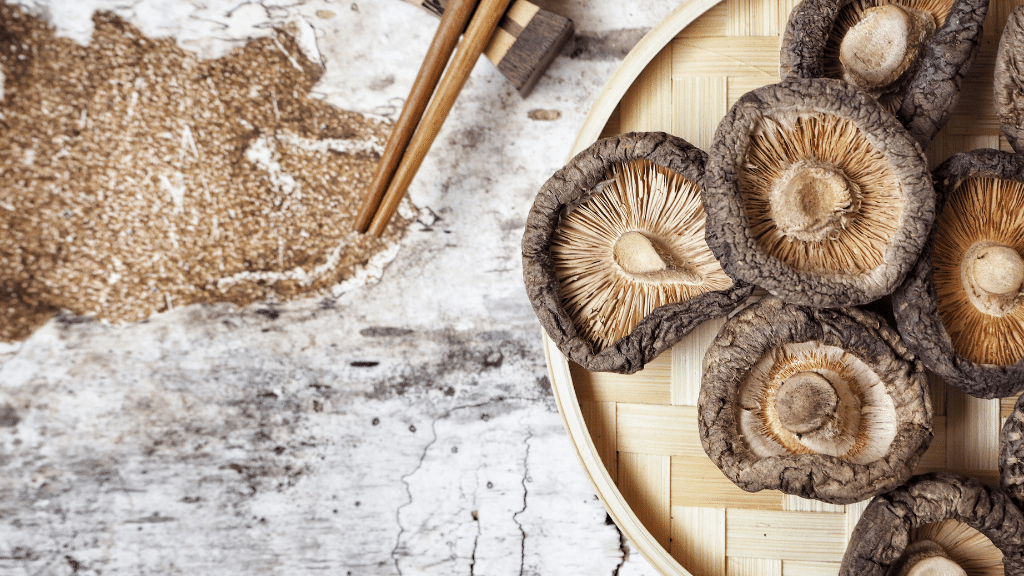
How to make shiitake tincture
Making shiitake tincture is as easy as drying your mushrooms, chopping them to expose more surface area, soaking in high-quality alcohol for 6-8 weeks and straining into tincture bottles. It's so easy to make your own mushroom medicine at home!
Here is how to make shiitake tincture:
1. Chop your dried mushrooms
Start by giving your dried shiitake a rough chop. This exposes more surface area and makes for a more potent potion. Don't worry too much about sizing. Just make sure the chopped pieces are large enough to not pass through your strainer or cheesecloth.
2. Add alcohol
Place your chopped mushrooms in the glass jar, filling it halfway. Pour in enough alcohol to completely submerge the mushrooms. The ideal ratio is about 1 part mushroom to 3 parts alcohol. Label your lid with the date. Then, set a calendar reminder for 6-8 weeks from that day!
3. Wait 6-8 weeks
Seal your jar tightly and whisper sweet nothings to it as you tuck it away in a cool, dark place. Your pantry perhaps? Maybe the top of your basement stairs? It should be cool but not cold in the storage area. (DO NOT store your tincture in the fridge!) Cold temperatures may slow down the process.
This is where patience is a virtue – let your mixture sit for 6 to 8 weeks, giving it a gentle shake now and then to make sure the mushrooms at the top get swapped down to the bottom.
4. Strain carefully
Once your tincture has matured, strain it through a cheesecloth or strainer into another clean jar. Squeeze or press to extract every last drop of mushroom goodness!
PRO TIP: What should you do with your mushroom leftovers? If you want to make a dual-extract tincture, you need to set aside your mushrooms now! We'll talk more about dual extraction in a bit.
5. Make Dual Extract OR Bottle It Up
If you're just making alcohol extract, you can transfer your tincture into amber bottles. These dark bottles are like cozy caves that protect your tincture from light, keeping it potent and fresh. If you want to make a dual extraction, set aside your strained mushrooms and keep your alcohol extract in a large container.
So, what if you want to make a dual-extract tincture?
What is a dual extract shiitake tincture?
A dual extract tincture is a type of mushroom extract that utilizes both water and alcohol in the extraction process to maximize the range of soluble compounds extracted from the plant or mushroom material.
This method is particularly beneficial for mushrooms, such as shiitake, reishi, chaga, and lion's mane, which contain a wide array of bioactive compounds, some of which are water-soluble, like polysaccharides (including beta-glucans), and others that are alcohol-soluble, like triterpenoids.
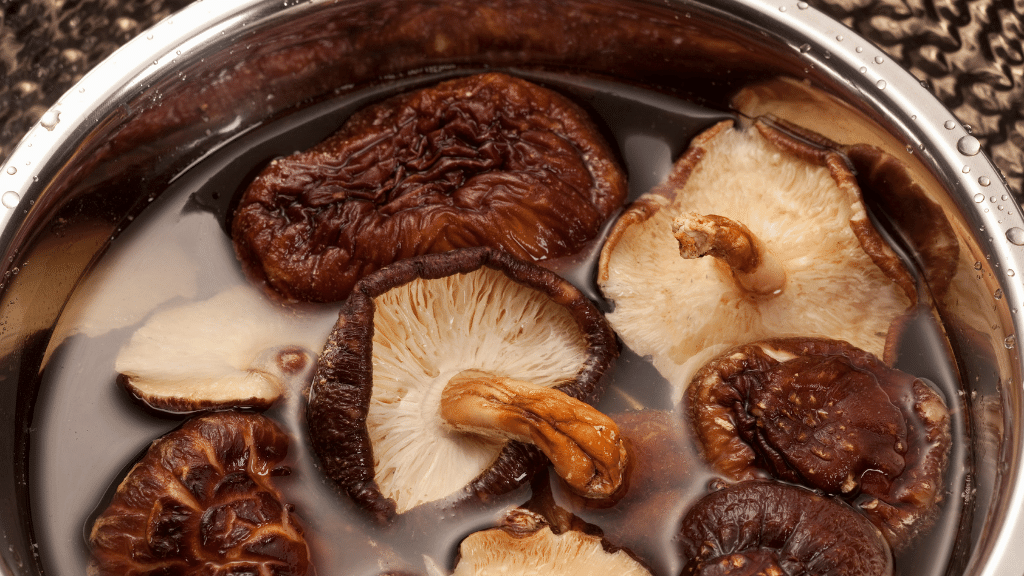
How dual mushroom extraction works
- Alcohol extraction: Dried mushrooms are submerged in alcohol, typically at a concentration of 40-70%, and left to sit for several weeks. This alcohol extraction phase pulls out compounds that are soluble in alcohol but not in water. The mushrooms are then separated from the alcohol, and the mushrooms AND alcohol mix are set aside.
- Water extraction: The second step involves simmering the reserved mushroom material from step 1 in very hot (but NOT boiling) water, usually for an extended period. This process is akin to making a strong tea and is effective at extracting water-soluble compounds. After simmering, the liquid is strained to remove the solid materials, and the resulting tea is set aside to be combined
- Combining alcohol and water extracts: After both extractions have been completed and strained of all solid materials, the water and alcohol extracts are combined. The alcohol also acts as a preservative, extending the shelf life of the water extract, which would otherwise be prone to spoilage.
We have a complete guide to mushroom extraction if you really want to dive in here.
Why use dual extracts?
The advantage of a dual extract tincture lies in its ability to harness a broader spectrum of a mushroom's or herb's therapeutic compounds than could be achieved through a single extraction method alone.
For example, the immune-modulating beta-glucans in shiitake are best extracted with water, while the anti-inflammatory or liver-protective triterpenoids require alcohol to be effectively extracted.
By combining both methods, a dual extract tincture offers a more comprehensive profile of the plant's or mushroom's potential health benefits.
How to make dual extract shiitake tincture
Measure out 2x the amount of alcohol that you used for your tincture in water.
So if you used three cups of alcohol to make your tincture, use six cups of water in this step.
Combine the water and reserved alcoholy-mushrooms in a heavy-bottom saucepan.
What if I accidentally threw away my reserved mushrooms? No problem! You can do this step with new dried shiitake mushrooms.
Set your mushrooms & water on your stove using the absolute LOWEST temperature setting. You want the water to be very hot but NOT boiling!
Simmer until the water has reduced by at least half (if not slightly more). This may take an hour or more, depending on the volume of water, your pan, and temperature settings. Keep a close eye on it! You don't want all your medicine to evaporate!
Once your mushroom tea is reduced, remove ALL the mushroom material (you can now throw it away!) and combine it with the reserved mushroom alcohol you set aside.
Your super-concentrated mushroom tea and your alcohol steep are now a dual-extract tincture!
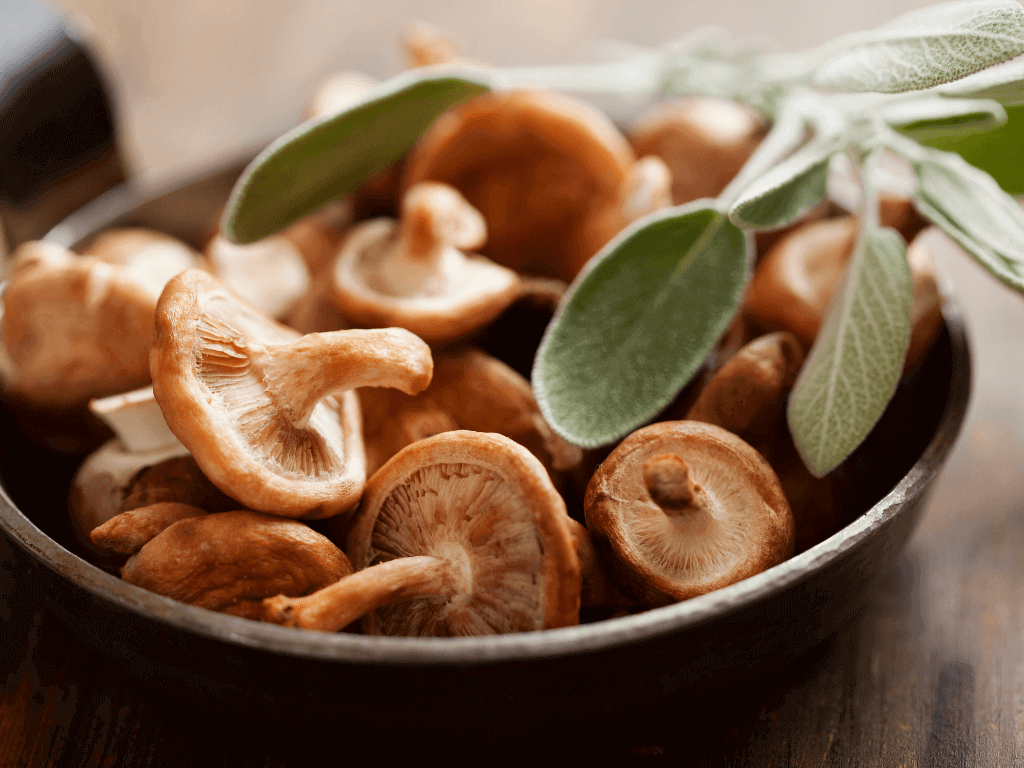
What are the health benefits of shiitake tincture?
Shiitake mushrooms are celebrated not only for their rich, savory taste but also for their impressive array of health benefits.
These benefits include:
Immune system support
Shiitake mushrooms contain polysaccharides like lentinans and beta-glucans, which help to stimulate the immune system, enhancing its ability to fight off infections and diseases.
A study in healthy, young adults was done over 4 weeks, adding shiitake mushrooms into their daily diet. The results found that consumption led to improved immunity. Along with other mushrooms, shiitake also contains a polysaccharide, beta-glucans.
Fungal beta-glucans have been extensively studied for their ability to boost the immune system, while having anti-inflammatory properties among other health benefits. It’s one of the many compounds you’ll want to be familiar with for their medicinal value.
Heart health
Consuming shiitake mushrooms may contribute to heart health in several ways. They contain compounds that help to lower cholesterol levels and blood pressure, reducing the risk of heart disease. Shiitake mushrooms also contain sterols, which can help to block cholesterol absorption in the intestines.
In a study done on rats, it was found that a diet comprised of shiitake mushrooms reduced serum lipids. Basically, having a higher level of lipids (fats) in your blood can increase the risk of heart disease and other corresponding health conditions. The diet of shiitake mushrooms was said to lower this level, which may promote better heart health.
Anti-cancer properties
The lentinan in shiitake mushrooms has been shown to have anti-cancer properties. Studies suggest that it can inhibit the growth of cancer cells and improve the survival rate of patients with certain types of cancer.
In one study on lentinan, an active polysaccharide in shiitake, “clinical data show solid effect of lentinan on improving the quality of life and on promoting the efficacy of chemotherapy and radiation therapy during cancer treatment.”
Antimicrobial effects
Shiitake mushrooms have been found to have antimicrobial properties in in-vitro animal studies, making them effective against a variety of pathogenic microorganisms.
In the realm of natural remedies, shiitake mushrooms just scored some serious points in the fight against gum disease. Leveraging the power of double extraction—combining both hot water and ethanol methods—researchers have unveiled shiitake's potent antibacterial prowess. When put to the test against notorious periodontal pathogens, including the likes of Fusobacterium nucleatum and Porphyromonas gingivalis, shiitake extracts demonstrated a remarkable ability to inhibit bacterial growth at a minimal concentration of just 3.12 μg/ml, effectively clearing out these harmful bacteria within two hours of exposure. This study not only reinforces the culinary appeal of shiitake mushrooms but also positions them as a potential ally in maintaining oral health, showcasing their significant antimicrobial effects against specific bacteria linked to gum disease.
Don't want to make your own tincture? Then you're going to love Life Cykel's small batch high-quality shiitake tincture!
Supports bone health
Being rich in vitamin D when exposed to sunlight, shiitake mushrooms can support bone health by improving calcium absorption and reducing the risk of osteoporosis.
Mushrooms are a great source of Vitamin D, but did you know that shiitake mushrooms are one of the best? Just 3 ounces of shiitakes provides over 20% of the daily recommended value of Vitamin D. That's pretty impressive!
Check out this guide on how to boost the vitamin D content of your mushrooms at home.
Anti-inflammatory properties
Components in shiitake mushrooms, such as polysaccharides, can help reduce inflammation, potentially benefiting conditions like arthritis and other inflammatory diseases.
Plus, they are a natural source of antioxidants that can help protect your skin from damage caused by free radicals. Shiitake mushrooms also have a pretty high percentage of selenium.
Selenium has been studied to protect the skin from UV radiation and has been used to treat and prevent psoriasis.
Nutritional benefits
Shiitake mushrooms are a good source of B vitamins, which are essential for converting food into energy and maintaining healthy brain function. They also provide essential minerals such as selenium, copper, and zinc, which support various bodily functions from antioxidant defense to immune response and skin health.
Learn more about the health benefits of shiitake mushrooms in our complete guide.
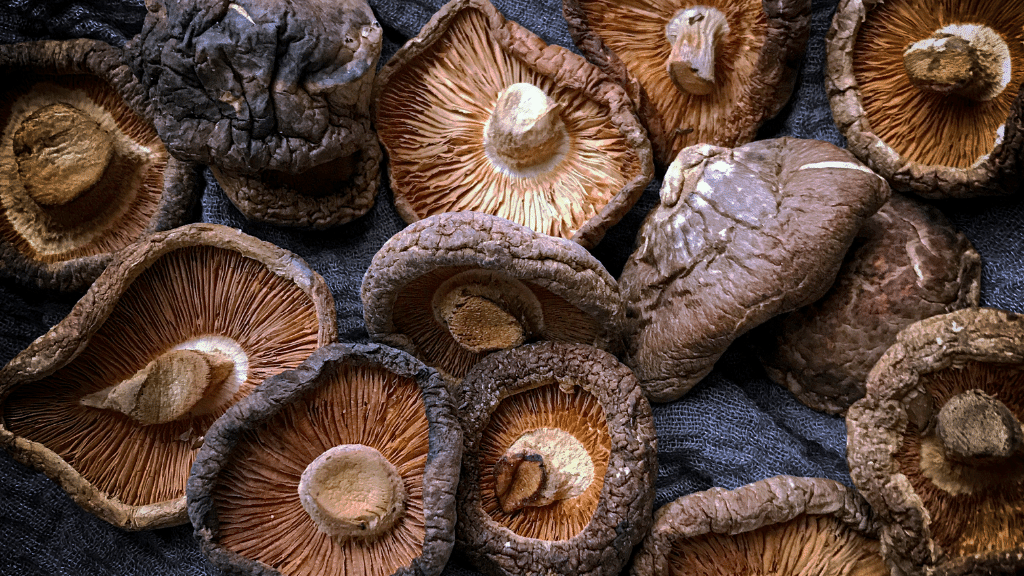
FAQs About Shiitake Mushroom Tincture
1. What is shiitake mushroom tincture?
Shiitake mushroom tincture is a liquid extract made from shiitake mushrooms (Lentinula edodes), leveraging alcohol and/or water to pull out the beneficial compounds. It combines the health-promoting properties of shiitake into a concentrated form that's easy to consume.
2. How is shiitake tincture made?
Shiitake tincture typically involves a dual-extraction process. Initially, the mushrooms are subjected to hot water extraction to dissolve water-soluble compounds. Following this, an alcohol extraction takes place, targeting alcohol-soluble constituents. This process can also be reversed, starting with alcohol. The two extracts are then combined to form a potent tincture.
3. What are the benefits of shiitake tincture?
Shiitake tincture is rich in bioactive compounds that offer various health benefits, including immune system support, potential anti-cancer properties, improved cardiovascular health, and antibacterial effects, particularly against pathogens associated with gum disease.
4. How do you use shiitake mushroom tincture?
Shiitake tincture can be consumed directly under the tongue for quick absorption or added to water, tea, or any beverage of your choice. The typical dosage varies, but starting with a few drops and gradually increasing as needed is recommended.
5. Can anyone take shiitake tincture?
While shiitake tincture is safe for most people, those who are pregnant, breastfeeding, have mushroom allergies, or are on medication should consult a healthcare provider before starting any new supplement regimen.
6. How long does shiitake tincture last?
When stored properly in a cool, dark place, shiitake tincture can last for several years. The alcohol acts as a preservative, extending its shelf life.
7. Are there any side effects of shiitake tincture?
Shiitake tincture is generally well-tolerated, but some individuals may experience digestive upset or allergic reactions, especially if they have a sensitivity to mushrooms. Starting with a low dose to assess tolerance is wise.
8. Can I make shiitake tincture at home?
Yes, making shiitake tincture at home is possible with dried shiitake mushrooms, high-proof alcohol, water, and a bit of patience. The dual-extraction method ensures you get the full spectrum of benefits.
9. How should I store shiitake tincture?
Store your tincture in a cool, dark place, ideally in amber or dark-colored glass bottles to protect it from light, which can degrade its quality over time.
10. Can shiitake tincture replace whole shiitake mushrooms in my diet?
While shiitake tincture provides a concentrated form of the mushroom's beneficial compounds, it's not a complete substitute for whole mushrooms, which contain dietary fiber and other nutrients. It's best used as a supplement to a balanced diet.



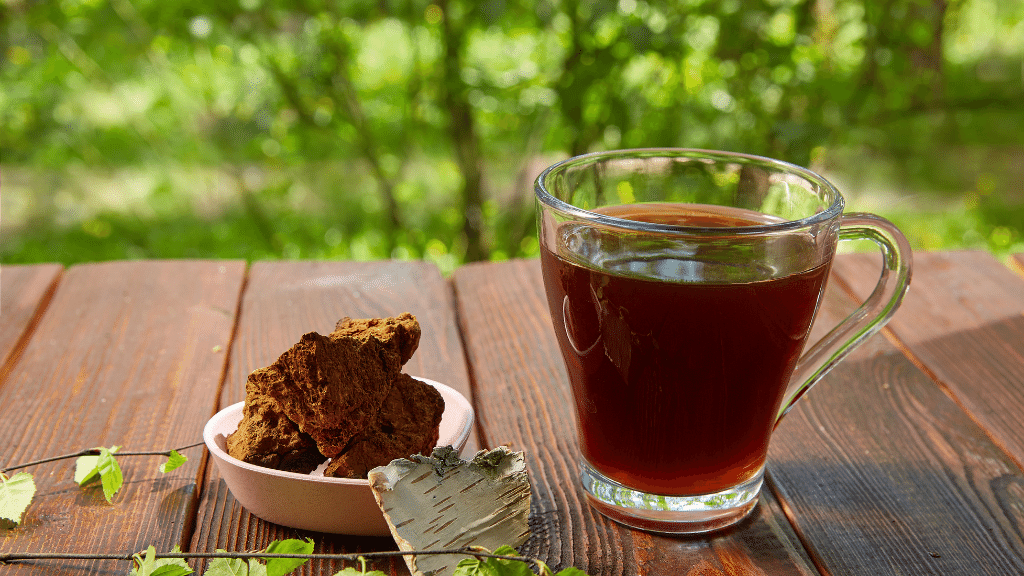
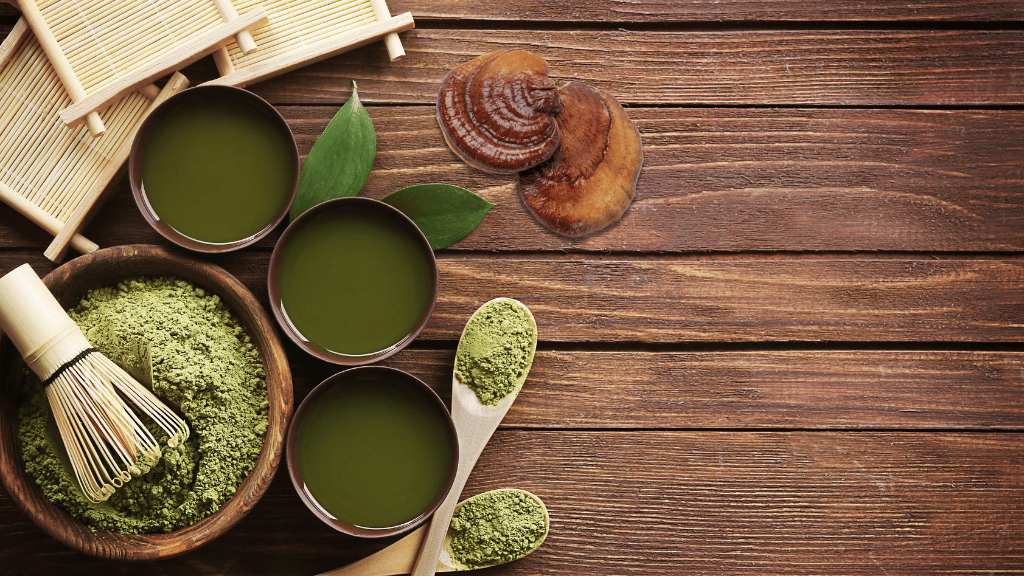


.png)
